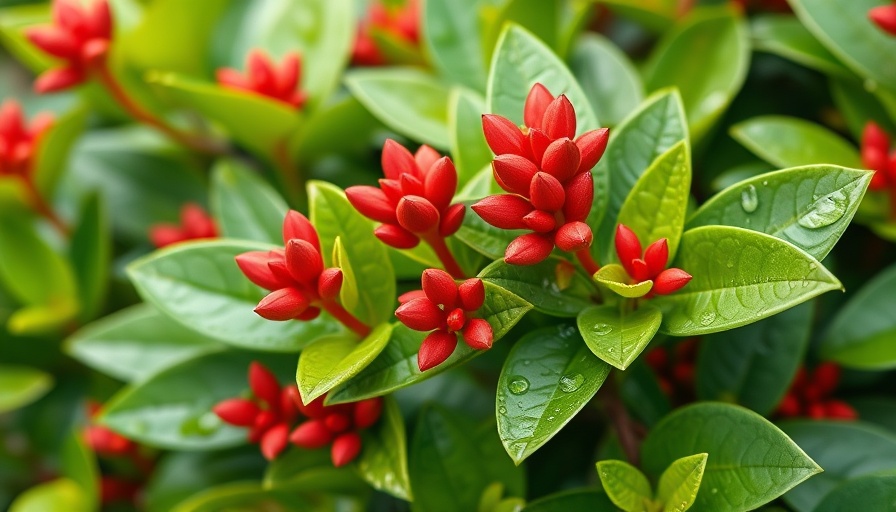
The Hidden Gem of the Garden: Understanding Japanese Skimmia
Skimmia japonica, commonly known as Japanese skimmia, is a delightful broadleaf evergreen shrub prized for its ornamental capabilities and vibrant spring blooms. Native to the lush landscapes of northeast Asia, including Japan and Taiwan, it thrives in USDA Hardiness Zones 6 to 8, making it an excellent choice for gardeners in temperate climates. With its rich cultural background and distinctive characteristics, Japanese skimmia offers a unique addition to any garden design.
Growing Your Own Japanese Skimmia: A Step-by-Step Guide
When deciding to cultivate Japanese skimmia, it is crucial to provide the right growing conditions. This adaptable shrub prefers partial shade and well-draining, organically rich soil with a pH range from 5.0 to 7.4. Planting in a spot that receives dappled sunlight will help it flourish while minimizing stress from the harsh afternoon sun.
Start by selecting a suitable cultivar. While the dioecious nature of skimmia means plants are typically either male or female, hermaphroditic varieties exist, providing versatility for gardeners looking to ensure prolific fruiting. For example, consider the S. japonica subsp. reevesiana, which can produce fruit without the need for cross-pollination.
Maintenance and Care Tips for Long-lasting Health
Japanese skimmia is a low-maintenance shrub, making it appealing for both novice and experienced gardeners. In general, these plants require minimal pruning due to their slow growth nature, but occasional pruning can help maintain their shape and prevent overcrowding. Regular watering during dry spells is essential, as skimmia prefers consistent moisture. However, avoid waterlogging the soil to prevent root rot.
Additionally, mulch around the base of the plant aids in moisture retention while keeping weeds at bay. Organic mulch also contributes to soil health as it decomposes. Fertilizing once a year with an organic fertilizer will promote healthy growth and flowering.
Integrating Japanese Skimmia into Your Landscaping Ideas
With its beautiful paired white flowers and glossy green leaves, Japanese skimmia is perfect for various landscaping projects. This evergreen shrub seamlessly fits into mixed borders, often serving as a mid-level focal point beneath larger deciduous trees or alongside other shrubs. Its neat size of 3-4 feet tall by 4-5 feet wide makes it suitable for foundation plantings, mass plantings, or even as a decorative container plant flanking an entrance.
For those looking to create vibrant outdoor living spaces, consider using skimmia to create garden borders or as part of a colorful flower garden, enhancing visual interest with other seasonal blooms. Just be mindful that some skimmia plants produce toxic fruits – beautiful but not edible.
Identifying Pests and Diseases: A Proactive Approach
While Japanese skimmia is generally resilient, it is not entirely free from pests and diseases. Aphids, spider mites, and scale can occasionally threaten plant health. Implementing a regular inspection schedule and promptly addressing any signs of infestation will ensure that your skimmia remains a healthy part of your landscape.
Additionally, maintaining appropriate moisture levels and ensuring good air circulation around plants can help reduce the likelihood of fungal diseases. Should you encounter more severe issues, organic pesticides can be a viable solution for maintaining plant health without damaging the surrounding environment.
A Lasting Impression: The Seasonal Appeal of Skimmia
One of the joys of planting Japanese skimmia is its seasonal interest. In spring, the plants burst forth with showy panicles of white blooms, adding elegance to any garden. As winter approaches, the vibrant red drupes appear on pollinated female specimens, creating striking visual interest during colder months. These features make it not just a versatile plant for structural form, but also an enjoyable addition throughout all seasons.
Conclusion: Start Your Skimmia Journey Today
Whether you're a seasoned gardener or just beginning to explore the joys of outdoor living, incorporating Japanese skimmia into your landscape is a rewarding choice. Engaging with this attractive shrub not only brings aesthetic appeal but also provides a sense of connection to nature’s beauty. So grab your garden tools, select the perfect spot, and enjoy the delightful journey of nurturing your very own Japanese skimmia.
 Add Row
Add Row  Add
Add 




Write A Comment